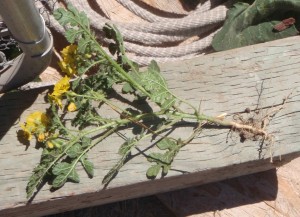
I don’t know how the first buffalo burr plant got onto my property about 4 years ago. I have lived here 14 years without ever seeing it or knowing it existed. Then, one day, there it was growing in my garden. It looked like a cute little watermelon volunteer seedling, growing low to the ground. And then I touched it. (click on any photo to enlarge)

Right away it went to the top of my hit list. This weed has long, sharp spines everywhere. Once it gets going, it grows quickly, becoming quite bushy. The flowers are yellow and basically round, but the slightly torn looking, uneven edges with the long anthers in the middle hint of it’s wickedness. It flowers around here from June to August; and seeds from July to October.

Fortunately, pulling it is not terribly difficult, as long as the hands are protected by gloves. A little loosening of the soil with a spading fork and the main tap root comes right out. It is also susceptible to glyphosate (generic of chemical for Round-Up), but mostly before flowering.

Interesting facts about buffalo burr:
- It got it’s name because of it commonly sticking to buffalo fur to hitch a ride.
- It seems to grown all over North America, where it is considered indigenous, except for Florida.
- It becomes a tumble weed when it matures and dries, snapping at the base of the stalk and taking all those seeds along.
- There are an estimated 8500 seeds per plant.
- It is categorized as an annual nightshade, thus in the same grouping as tomatoes and potatoes.
- It is also known as Kansas thistle or prickly nightshade.
- The Colorado potato beetle likes to live in it.
- It has migrated to Australia circa 1900, but seems confined to the more southern regions so far.
- The leaves and fruit are poisonous to livestock, particularly cattle, but they usually don’t eat it because of the spines.
- When ingested, very small amounts can be deadly from both the nervous system and gastrointestinal effects.
- It is called a noxious weed everywhere that it occurs.

Oh, ugly! I didn’t know you had that. I don’t thing we have any, but now I will be on the look-out! Maybe you had a tumble weed blow thru your yard sometime?? Delivering all it’s “precious” seeds.
It’s kind of strange to remember the first time I saw a certain type of weed!
Oh your dad said it was probably those buffalo that ran through your yard awhile back. ! 🙂 🙂 🙂 [or maybe brought back from those wild trips to the desert?”
😀 Sharon also commented (on the FB link) that there must have been some mystical white buffalo spreading seed in the black of night…. ha ha ha